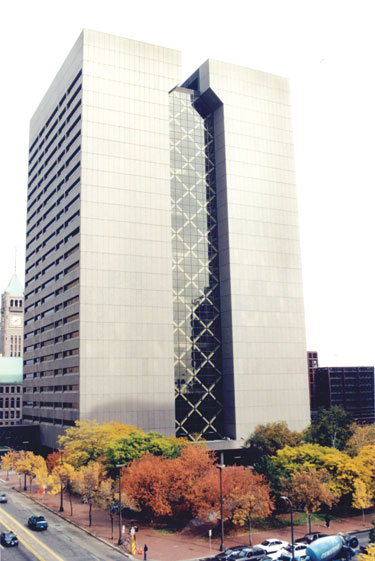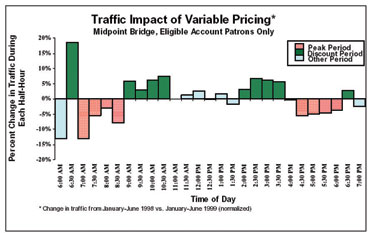Hennepin County - MN
FAST FACTS ABOUT: Hennepin County - MN
Types of TDM: Modal Shift, Location Shift
Keywords: Transit subsidy, Pre-Tax benefits, Legislation
Employer Demographics: Hennepin County, Minnesota,
has 130 offices and facilities dispersed throughout the county with
differing levels of transit service at each site. About 10,000 County
employees are located in downtown Minneapolis and are well served by
transit.
Results: Estimated 60% drive alone, 15% carpool, 2%
vanpool, 15% bus, 3% telework, 5% flextime
Cost: $559,000 bus subsidy + $14,000 vanpool, parking
and administration costs = $573,000 - $109,000 FICA Savings = Total
Cost: $464,000.
Staff: Minimal staff time and staff costs once program
was set up.
Contact: Mike Bastyr, Sr. Human Resources Representative,
612-348-4640

Local and Federal Legislation and Policy Impacts
Since 1960 the City of Minneapolis’s growth management policies
concentrated office and retail use in a downtown core and limited parking
to areas just outside the core. These policies have resulted in high
bus service and ridership in the downtown core, where most of Hennepin
County’s employees work.
Like many other US cities, Minneapolis is recently experiencing a resurgence
in downtown growth and development. As Minneapolis’s downtown
core continues to grow, city and county officials have become concerned
about increasing congestion and decreasing air quality.
In 1999 Minneapolis expanded the smart growth policy in their City Comprehensive
Plan to include more emphasis on transit. Per the plan, “Minneapolis
will follow a policy of ‘Transit First’ in order to build
a more balanced transportation system than the current one.”
In addition to the local “Transit First” policy, federal
legislation passed in 1999 encouraged employers throughout the United
States to reevaluate their transportation benefits programs. Internal
Revenue Code Section 132 (f), allows employees to exclude certain transportation
fringe benefits from gross income. In 1998, these pre-tax fringe benefits
were limited to $65.00/month for transit or vanpool and $175.00/month
for qualified parking. In 2000, the benefit limits were increased to
$100/month for transit or vanpool and $195.00/month for qualified parking.
The convergence of local policy and federal
legislation provided the impetus for Hennepin County to reevaluate its
20-year old bus pass program.
The convergence of local policy and federal legislation provided the
impetus for Hennepin County to reevaluate its 20-year old transportation
program. During the 1980’s and 1990’s Hennepin County’s
transportation program consisted of a pay-roll deducted bus pass. Convenience
and a 5% discount from the local transit authority, MetroTransit, motivated
employee bus pass purchases. In 1999, spurred by new federal transportation
benefit regulations, Hennepin County introduced a pre-tax employee transportation
program that covered bus and parking costs (in 2000).
Pre-Tax and Creative Use of Savings
Hennepin County’s pre-tax transit pass program, available to all
13,000 employees, immediately increased transit usage by 400-500 employees
spread throughout the County’s dispersed offices.
Soon after Hennepin County’s introduction of the pre-tax transit
program, MetroTransit, introduced a metro pass. Although employees voiced
interest in the metro pass, the cost was too high for Hennepin County.
Instead, in 2000, the County enhanced the transit pass program by providing
a 40% discount on transit pass purchases. The combined subsidy and pre-tax
status of the transit pass reduced costs for the employee. Transit purchases
increased to over 1,900 by January 2003.
As an employer, the pre-tax bus and parking program saved the County money on FICA payments. The County decided to filter the FICA savings back to offset the subsidy program. Doing so defrays 30% of the cost to provide the subsidy. From June 2000 through January 2003, the subsidy, less the FICA savings, totaled $666,464.

Results and Challenges
Due to the high level of bus service in the downtown core, Hennepin
County’s marketing and outreach is focused on encouraging bus
ridership. The combination of subsidies and pre-tax incentives captured
the attention of employees and increased bus ridership by almost 900
employees in one year. Success for Hennepin County is measured by increased
participation in the transit subsidy program. Since the changes in the
program, SOV rate has reduced to approximately 60% with an estimated
15% of employees carpooling, 2% vanpooling, 3% teleworking, 5% using
flextime and 15% utilizing transit.
Despite the initial success of the transit subsidy/pre-tax incentive
program, employees complained about the confusing pre-tax parking process.
As the pre-tax parking benefits operate differently than the popular
and familiar flexible spending accounts, employees became frustrated.
Hennepin County’s Benefits Unit kept an open-door policy and sought
and responded to feedback on a regular basis. County newsletter articles
and e-mail announcements were used to both inform and clarify the program
to employees.
One employee responded to a newsletter article with an e-mail stating,
“Pre-tax parking is confusing and stupid.” That quote was
used as the title for an employee mailing that explained changes that
made the program easier for employees to use. Feedback loops and consistent
updates increase the appeal to employees, and therefore participation.
The local MetroTransit group recognized Hennepin County’s innovative
funding model with a transportation benefits program award.